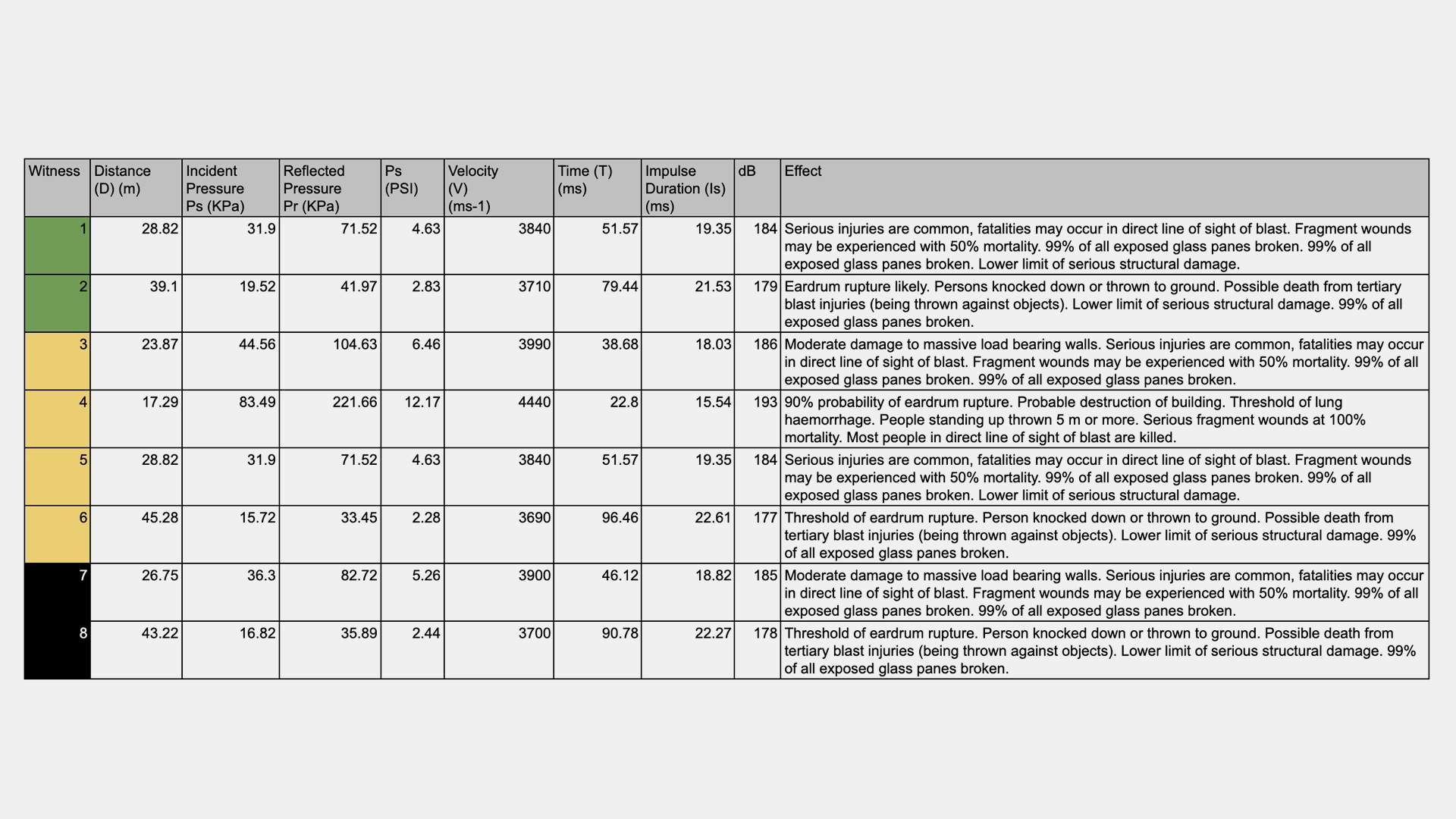
Explosion analysis
The Center for Spatial Technologies (CST) commissioned defense consultant and engineer Gareth Collett to conduct an in-depth analysis of the explosives used in the Mariupol Drama Theater attack. Drawing on his extensive experience in bomb disposal and his knowledge of Russian war tactics, Collett examined evidence collected by CST, including photos, videos, 3D models, and selected eyewitness testimonies to craft his report.
Collett's findings indicate that the explosion targeted the theater's stage area, as evidenced by the outward debris dispersion. His analysis emphasizes the internal collapse of girders (structural beams), dispersed pieces of the roof, and a metal roof pierced by shrapnel.
The shape and damage caused by the blast indicate that a large, cylindrical explosive device detonated between the ceiling and floor of the theater, triggered by a time delay fuze to enhance the explosion's effect inside the building. The absence of a crater implies the device exploded in the air rather than upon hitting a surface. The path of the warhead indicates it was dropped from a weapon platform flying east at a moderate altitude.
Mr. Collett's analysis suggests a large bomb, equivalent to at least 114 kg of TNT, likely dropped from an aircraft, caused extensive damage to the Mariupol Drama Theatre. Mr. Collett's review of Russian air-dropped munitions used in Ukraine identifies specific types of ordnances with an explosive power of 114 kg of TNT or greater. Discounting artillery rockets, cruise missiles, thermobaric/incendiary weapons, and fragmenting warheads based on witness accounts, precision needs, and damage patterns, the review narrows down to just two likely candidates: the FAB-500 M62 and the KAB-500S-E.
Unguided bombs, also known as “dumb bombs”, can achieve high levels of accuracy despite the lack of guidance systems attached to them, but usually with low precision, meaning they might not hit the exact intended spot. In this context, accuracy refers to how close the bombs come to the target, while precision indicates the consistency of where each bomb lands.
This means that without guidance systems, bombs might land more than 30 meters away from their intended target, like the theater, based on the pilot's accuracy. However, guided "smart" bombs, such as the KAB-500 series, are much more accurate. They have a Circular Error Probable (CEP) of 7 to 12 meters, showing the area where half of the bombs are likely to hit. This accuracy makes it very probable for them to strike a large target like the theater within this distance. Since the theater is located in an open space without any other significant buildings within 100 meters, it stands out as a lone target. This isolation is relevant regardless of the type of bombing—unguided or precision-guided. This fact suggests that the theater was intentionally targeted.
According to Collett, modeling of the explosions of both FAB-500 and KAB-500 variants identify the KAB-500S-E as the most likely munition used on 16 March 2022 on the Mariupol Drama Theater. This specific bomb combines the necessary precision and explosive power to create a significant overpressure, exceeding the level needed to cause the observed extensive damage.
Collett points out that the Su-34, often shown in Russian media carrying out operations in Ukraine, is the probable aircraft behind the Mariupol Drama Theater bombing. The Su-34 is capable of launching KAB-500L and KAB-500S guided bombs, and its pilots are seasoned in their use from missions in Syria.
The conclusions of the report are quoted below:
1. From the evidence provided, one or a pair of cylindrical blast warheads were likely dropped from an aviation platform on Mariupol Drama Theatre. This statement is consistent with the Russian Federation's air warfare doctrine in Ukraine.
2. The warhead(s) detonated within the theatre as an airburst, not a ground burst.
3. The damage is consistent with a TNT bare charge mass > 114 kg, which can produce overpressures above 68.9KPa at 18m (the minimum radius for almost complete destruction).
4. Whilst it is difficult to discount unguided ordnance (such as the FAB-500), it is more plausible that one or a pair of KAB-500S-E guided bombs were dropped on Mariupol Drama Theatre given their CEP.
5. Whichever item of ordnance was used, Mariupol Drama Theatre was an isolated structure, suggesting that an aircraft carrying guided or unguided bombs had designated the building as a target.
Blast and fragmentation impact analysis relative to witness positions
Upon finalizing the work with witnesses, CST passed the testimonies to Mr. Collett to conduct a supplementary analysis on the impact of the blast and subsequent fragmentation on witnesses within the Mariupol Drama Theater.
Mr. Collett's analysis revealed that individuals within 21 meters of the explosion’s epicenter faced a 99% fatality risk from reflected blast overpressure, and those within 207 meters “faced significant risk from fragmentation.” The people sheltering on the ground floor (locations 3, 4, 5, and 6) were at high risk but were shielded by the theatre's structure. Witnesses in locations 1, 2, 7, and 8, positioned farther from the blast, were protected by the building, significantly reducing their injury risk. The theatre's structure was crucial in shielding people, especially for witnesses in location 4, for whom, according to Mr. Collett, the explosion would have been lethal if not for the metal door between the technical room and the space of the stage. For each of the locations, Mr. Collett provides an assessment of the effect of the explosion on the human body, as visualized below.
Mr. Collett's investigation suggests a guided bomb likely caused severe damage to the Mariupol Drama Theater, pointing towards a deliberate targeting and bombing of the building by the Russian air forces. His work of detailed engineering analysis contributes to our witness testimonies, spatial models, and visual evidence in strengthening the case for warfare accountability.





